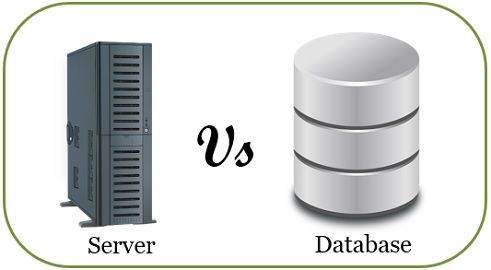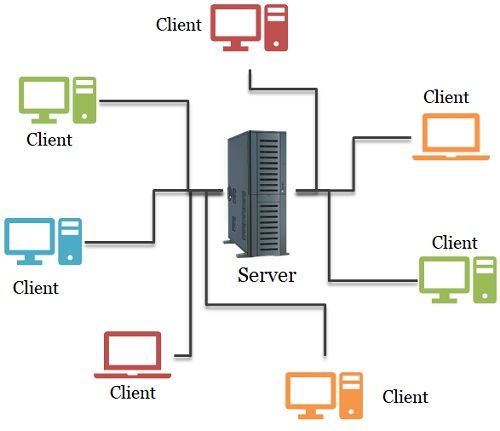 The basic difference between a server and a database is that server is a computer program that runs to provide services to other computer programs or devices. On the other hand, the database is an application that stores data in an organized form and can be retrieved by the user with the help of a query.
The basic difference between a server and a database is that server is a computer program that runs to provide services to other computer programs or devices. On the other hand, the database is an application that stores data in an organized form and can be retrieved by the user with the help of a query.
In the section ahead, we will be discussing the differences between server and database.
Content: Server Vs Database
Comparison Chart
| Basis for Comparison | Server | Database |
|---|---|---|
| Basic | It’s a computer program that provides the requested services to other devices or computer programs. | It’s a collection of data that is stored in an organized manner, and is accessed with the help of queries. |
| Services Offered | It offers server specific services. Like a web server will only provide the web-based services. | The database let you store the structured data in an organized manner. |
| Language | PHP, Python, Ruby, Java, ASP, etc. | The language used to define and manipulate database are DDL, DML, DCL, and TCL |
| Use | A server is used to provide services to many clients simultaneously. | A database is used to store and manage data. |
| Types | Web server, database server, proxy server, mail server, etc. | Cloud database, relational database, distributed database, centralized database, etc. |
What is Server in Networking?
A server is a physical computer with large a large disk drive that has a server program running on it. The server program provides services to other computer programs or devices (clients). The figure below illustrates the client-server model.

The client-server model is widely used and it forms the basis of much of the network usage.
What is Server Used for?
We use servers to provide services to the clients.
- Share (send and receive) data to/from multiple clients.
- Share resources among multiple clients.
- Storing data
Working of Server
The main function of a server is to provide the requested services to its clients. We can easily explain the working of the server with the help of the client-server model.
The model includes two processes i.e. a client process and a server process. The client process runs on the client machine and the server process runs on the server machine.
Now whenever the client needs any service it asks the server process, by sending a message. When the server process receives this message, it performs the requested task. Or if the request is for some data its lookups for the requested data and sends a corresponding reply.
Well, you can take the above explanation as a basic working of a server. If we explore it further the server can be a physical server, a virtual server or just a server software.
- Physical Server
It is a physical computer on which the server software runs. - Virtual Server
The virtual server is created on the physical machine. So, the virtual server has its own operating system and applications. To create a virtual server on a physical machine a software hypervisor is installed on the physical machine.
The hypervisor enables a physical machine to host several virtual servers by keeping the resources of one virtual server separate from the resources of another virtual server. - Server Software
Like any software the server software also requires a minimum of one resource to run i.e. operating system. The operating system provides the platform for server software to run. The operating system facilitates the server software to access the hardware resources.
Types of Servers
The most common type of server that we come across is the web server that provides you web base services. But there are several other types of servers.
- Web Server
It is the one that provides all the web-based services requested by clients over the World Wide Web. - Email Server
The email server manages to send and receiving of emails between the business clients. - Database Server
The database server is capable of hosting multiple databases. It manages the accessibility of clients to the data over the network. - Print Server
The print server coordinate between the printers connected to the clients in the network. - Game Server
It serves as a multiplayer gaming experience for the players present at different locations of the world. - Proxy Server
It is a server that acts as an intermediate between clients and the server to which the client has requested the service.
Advantages of Servers
- The server centrally controls the clients connected to a network.
- There is a dedicated server for every work.
- The server is scalable.
- The server facilitates easy backup and recovery of your data.
- You can remotely access the servers using various platforms.
Disadvantages of Server
- If too many clients send a request to the server at the same time it might lead to traffic congestion.
- Any failure in the centralized server may lead to the failure of the entire network.
- Installing and maintaining is server is a cost-effective process.
What is Database?
A database is an application that we use to store information in a structured way. It organizes the related data into a table under rows and columns. The user can retrieve data from the database with the help of queries.
What is Database Used for?
We use databases to store, maintain and retrieve the information. We even use it to aggregate or analyze the business information and take better decisions for the company’s benefit.
Types of Database
- Centralized Database
It stores data in the centralized database system. The user can remotely access the centralized database system with the help of some application. - Distributed Database
Distributed database as the name suggests, here we store data on the different database systems of the company. However, these distributed systems are connected to each other with the help of a communication link. The distributed database is further classified into two types:- Homogenous DDB
The data in homogenous DDB is distributed among various servers. But all these servers run the same DBMS software. - Heterogenous DDB
The data in heterogenous DDB is distributed among different servers that run with different DBMS software.
- Homogenous DDB
- NoSQL Database
NoSQL is ‘not only SQL’ database. It has a non-tabular structure and it stores data differently from the relational database. NoSQL databases stores data in various ways, it totally depends on the data model used.
The NoSQL database can store data in the form of documents, graphs, key-value and wide-column. - Relational Database
The relational database stores information in one or more tables of rows and columns. Each row in a table represents an entity and the columns represent the attribute of these entities. - Network Database
The network database is structured on the network data model. Here each record can have multiple parent records and multiple child records. Thus, the network database provides multiple access paths to the data. - Object-Oriented Database
It is a collaboration of object-oriented programming and a relational database. It stores in the form of objects that is nothing but the instances of the classes. - Hierarchical Database
A hierarchical database organizes data in a tree-like structure. Here each record has a single parent and multiple child records connected to parent records through links.
Key Differences Between Server and Database
- Basically, we use the server for providing the services to the clients associated with it. However, we use a database to store and maintain the data.
- The services offered by the server are specific to the kind of server. For example, a web server will only provide web-based services. However, the database allows you to store data in an organized manner.
- The languages used to construct server is PHP, Python, Ruby, Java, ASP etc. On the other hand, languages used to define database is DML, DDL, DCL, and TCL.
- A server serves multiple clients simultaneously. However, we use the database to store and manage the concerned information.
- The different types of servers are a web server, database server, proxy server, etc. However different types of databases are network databases, hierarchical databases, distributed databases etc.
Conclusion
So, we can conclude that both the server and the database have different purposes. We create a server to offer services to the clients connected to it. We create a database for storing data in an organized way.
Leave a Reply